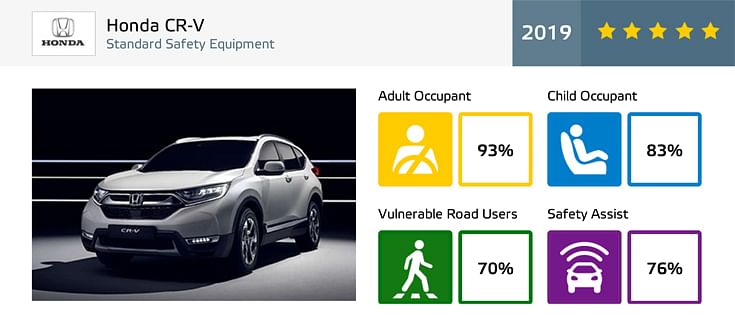New Honda CR-V gets five-star Euro NCAP crash test rating
The new Honda CR-V has been awarded the maximum five-star rating in the latest Euro NCAP safety tests, the results of which were announced today.
The new Honda CR-V has been awarded the maximum five-star rating in the latest Euro NCAP safety tests, the results of which were announced today. The CR-V has a unique body structure giving class-leading rigidity and stiffness, and a comprehensive suite of active safety technologies.

Utilising an ‘All Directions Collision Safety’ concept, the platform design incorporates Honda’s next-generation ACE (Advanced Compatibility Engineering) body structure. This employs a network of connected structural elements to distribute collision energy more evenly, helping to reduce the forces transferred to the passenger cell in the event of an impact, giving superior front, side and rear crash-worthiness.
The passive safety features on the all-new CR-V are complemented by the Honda Sensing suite of active safety and driver assist technologies. Honda Sensing is among the most comprehensive suites of safety technologies in its class. It uses a combination of radar and camera information, plus a host of high-tech sensors to warn and assist the driver in potentially dangerous scenarios.
According to Euro NCAP, "The passenger compartment of the CR-V remained stable in the frontal offset test. Dummy readings indicated good protection of the knees and femurs of the driver and passenger. Honda showed that a similar level of protection would be provided to occupants of different sizes and to those sitting in different positions. Protection of the passenger dummy was good for all critical body areas. In the full-width rigid barrier test, protection of the driver and rear passenger was good or adequate for all critical body areas.
"In the frontal offset test, dummy readings of tensile forces indicated marginal protection of the neck for the 10-year dummy. Otherwise,
protection of both dummies was good or adequate. In the side barrier test, protection of both child dummies was good and maximum points were scored. The front passenger airbag can be disabled to allow a rearward-facing child restraint to be used in this seating position. Clear information is provided to the driver regarding the status of the airbag and the system was rewarded. All of the restraint types for which the CR-V is designed could be properly installed and accommodated, including in the optional third row seats."
"In the side barrier test, protection of all critical body areas was good and the CR-V scored maximum points. In the more severe side pole impact, dummy readings of rib deflection indicated marginal protection of the chest. Tests on the front seats and head restraints demonstrated good protection against whiplash injury in the event of a rear-end collision. However, a geometric assessment of the rear seats indicated poor whiplash protection. The standard-fit autonomous emergency braking (AEB) system performed well in tests at the low speeds, typical of city driving,
at which many whiplash injuries are caused."
The new Honda CR-V joins the rest of the Honda range tested by Euro NCAP – Jazz, HR-V and Civic – in being awarded the maximum five-star score by Euro NCAP.
RELATED ARTICLES
Autoliv Plans JV for Advanced Safety Electronics With China’s HSAE
The new joint venture, which is to be located strategically near Shanghai and close to several existing Autoliv sites in...
JLR to Restart Production Over a Month After September Hacking
Manufacturing operations at the Tata Group-owned British luxury car and SUV manufacturer were shut down following a cybe...
BYD UK Sales Jump 880% in September to 11,271 units
Sales record sets the UK apart as the largest international market for BYD outside of China for the first time. The Seal...






 By Autocar Professional Bureau
By Autocar Professional Bureau
 27 Feb 2019
27 Feb 2019
 12897 Views
12897 Views
































 Ajit Dalvi
Ajit Dalvi




